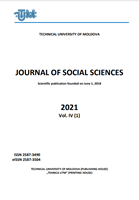CYBERSECURITY OF THE REPUBLIC OF MOLDOVA: A RETROSPECTIVE FOR THE PERIOD 2015-2020
CYBERSECURITY OF THE REPUBLIC OF MOLDOVA: A RETROSPECTIVE FOR THE PERIOD 2015-2020
Author(s): Dinu Turcanu, Natalia Spinu, Serghei Popovici, Tatiana TurcanuSubject(s): Security and defense, Social Informatics, ICT Information and Communications Technologies
Published by: Universitatea Tehnică a Moldovei
Keywords: CERT-GOV-MD; computerization; concept; cyber-attack «Digital Moldova 2020»; law; National Program; risk management; strategy;
Summary/Abstract: The process of implementing information technologies in all areas of economic, political, social life, etc. in the Republic of Moldova has also determined the evolution of cybercrime. New “virtual” dimensions of national infrastructure are being formed, which are becoming more and more important for local and international politics. As a result, in recent years it has been found that computer systems, networks and data are being used more and more frequently for criminal purposes, and the materials that could be evidence of these crimes are also stored and transmitted through these networks by perpetrators. Cybercrime, espionage, propaganda, diversion and excessive exploitation of personal data through electronic communications networks are used as basic tools at all stages of designing a hybrid security threat. Cyberspace-specific threats are characterized by asymmetry and accentuated dynamics and global character, which makes them difficult to identify and counteracted by measures proportional to the impact of the materialization of risks. Moldova is currently facing threats from cyberspace at the address of critical infrastructures, given the increasing interdependence between cyber infrastructures and infrastructures such as those in the financial banking, transport, energy and national defense sectors. The globality of cyberspace is likely to amplify the risks to them by affecting both the sector to the same extent private as well as public. Threats to cyberspace can be classified in several ways, but the most commonly used are those based on motivational factors and the impact on society. In the prevailing conditions cybersecurity is becoming one of the most important areas for ensuring internal security and the effective operation of state institutions in all spheres of social and economic life.
Journal: Journal of Social Sciences
- Issue Year: IV/2021
- Issue No: 1
- Page Range: 74-83
- Page Count: 10
- Language: English

